Ghost in the Shell: Stand Alone Complex is an anime series that is based on the same Manga that inspired two films (both reviewed on Kaedrin previously). For the most part, it deals with similar subjects and themes, though it does so in a less somber and more prosaic manner, sometimes even finding room for humor and the occasional smile. Despite some flaws, I thoroughly enjoyed the series and if you enjoyed the movies, I don’t see why you wouldn’t enjoy the series.
The series is comprised of a mixture stand alone and continuity (or as they call it, “complex”) episodes. There is a good balance between the two types of episodes, though I do think that some of the stand alone episodes felt a little rushed and could have benefited from having more time to flesh out the stories (whether that be longer episodes or splitting the story up into two episodes). That said, the stand alone episodes are still entertaining and often contribute towards the larger series (i.e. they’re not completely stand alone). The continuity episodes tell the story of The Laughing Man, a masterful hacker and terrorist who has been blackmailing major corporations for six years.
Thematically, this series touches on many of the same issues as the films, but in a less direct fashion. The movies could be mind-numbingly dense at times, often directly confronting the philosophical implications of the technology in their universe (a subject I find interesting and discussed in my reviews of those movies). There are occasional info-dumps or philosophical discussions in the series, but nothing on par with the films. However, many of these technological issues come to light as a part of the plot, which tends to move forward as a result of action rather than conversations. This works well after having seen the two movies, though I’m not sure how well it would work if you haven’t seen either of them. If I had to guess, I’d say this series still raises all the fascinating questions the films does, just in a less direct fashion. What makes me what I am? Am I really who I think I am? If I could copy my brain into a computer network, would that still be me? If I could swap “shells” (bodies) or project my “ghost” (i.e. soul) into another shell, is that me? Again, the series doesn’t confront these issues directly, but it does use such technology in service of the story, which begs the questions. What would the subjective experience of transferring your consciousness from one body to another be like? Can a machine develop or have a ghost? What’s the difference between an artificial body (like the Major has) and an avatar (like the Major uses in episode 9)? And so on.
Another interesting thing about the series is external memory, or memories that are not stored in your brain (but on some other media, like a hard drive). These devices are referenced much more frequently in this series than in the movies, and I found it interesting because that is the direction we’re heading. The internet has created this phenomenon wherby you think you know something, but you really don’t… you just know where to look up the information on the internet. Obviously, this isn’t new (or unique to the internet), but it is accelerating. It reminded me of Charles Stross’ book Accelerando, a book I didn’t particularly love and never actually finished, but which had some interesting technological musings. At one point in the book, a character who stayed in constant communication with the net via a pair of glasses has them stolen. Without the glasses (i.e. without access to his external memory), he feels profoundly lost and unable to cope with reality. Obviously, we haven’t reached that point yet, but GitS:SAC shows several examples of this sort of thing.
There are some new themes as well, namely the titular Stand Alone Complex, which refers to a phenomenon where you see emergent copycat behavior without an original. For example, let’s say that someone dies in suspicous circumstances. The death could very well be attributed to natural causes, but some people might be tempted to call it a murder or conspiracy, and even others might take the opportunity to commit a copycat murder. The situation could escalate into a series of murders, all by different copycat killers. This is a stand alone complex, and it’s distinct from normal copycat behavior in that the original death was not actually a murder. As Chief Aramaki notes, they’re “Nothing but copies without an original.” It’s something of an odd concept, and it’s a little difficult to understand during the series, but it does touch on many concepts I find fascinating, such as emergent, self-organizing behavior. It also appears in several forms throughout the series, with direct references, but also in more subtle ways. For example, the Laughing Man’s logo is basically a second-order simulacra, which is a symbol without a referant. The symbol contains a quote from Catcher in the Rye and the name Laughing Man is a reference to another Salinger story, but the symbol doesn’t really represent either, nor does it actually represent what became known as “The Laughing Man.”
The main characters of the series are the members of a special operations task-force called Public Security Section 9. This is a small team of around 8 well trained and competent members whose main charter is to perform search and rescue operations, but this ends up leading to counter-terrorism and more general anti-crime tasks. You get a much better idea of what this organization is during the series, and you also get to know its members a little better (though perhaps not as much as I liked, more on this later). Many of the members who only have fleeting appearances in the movies take on a more solid role in the series. The team seems to be highly autonomous and independent, picking and choosing their targets carefully, but often without interference from the rest of the government. This is probably due to the political leader of the group, Chief Aramaki. Members of the team also share this autonomous and independent attitude and are often trusted to carry out tasks without any intrusion from others. Aside from the Chief and Major Kusanagi (who seems to have emerged as the team’s combat leader), there don’t appear to be any ranks or jobs, though it’s obvious that some members of the team have certain specialties (for instance Ishikawa is almost always at a computer terminal, crunching numbers or tracking down the “ditigal paper trail” of whoever Section 9 is hunting, and he almost never enters battle. On the other hand, Batou is clearly a brute force combat specialist who almost never messes around with information warfare.)
Again, the movies tend to be more philosophically inclined than the series, which seems content to let the philosophical implications of their universe simmer beneath the surface of a straightforward police procedural (albeit one that is spiced up with hackers, an addition that actuall works well). There are occasions when the philosophy comes to the foreground though, such as episodes 12 and 15, both of which deal with Section 9’s AI-equipped mini-tanks, the Tachikomas. In a previous post on Gits:SAC, Author wondered if I was liking the Tachikomas, which gave me the impression that they’re dislikd in the Anime world (not sure about that though). To be sure, the Tachikomas do seem to have a child-like demeanor (they’re voiced in high pitched, young sounding female voices, for instance) and often make naive statements. These “cute” characteristics are odd when considering that they are combat vehicles. Conceptually, however, they do provide fodder for one of the interesting themes of the GitS universe, namely the question of whether or not a machine can acquire a ghost (aka a soul). In the series, Tachikomas have artificial intelligence… however, they are synchronized every night so they have identical memories. This leads to some confusion later on, as memories experienced by a specific Tachikoma become shared amongst all the other Tachikomas… which begs the question of which one of them actually experienced the event (they can’t figure it out). It is interesting that despite the synchronization process, the Tachikomas somehow manage to develop individual and distinct personalities. So even though they “wake up” every morning with the same memories, they still exhibit differing personalities and opinions (for example, one of the Tachikomas spends all its time reading paper books… every night, the memory of reading these books is synchronized with the other Tachikomas, but this one Tachikoma is the only one that continues to read).
In Isaac Asimov’s robot novels, one of the main characters, a humanoid robot named R. Daneel Olivaw, mentions that while he cannot experience emotions, his positronic circuitry seems to run more smoothly when he’s around Elijah Baily (his human parter). When thinking about the potential paradoxes created by the synchronization process, I thought of Olivaw. The engineer in me also thought of tolerances and chaos theory, meaning that even though each Tachikoma has it’s memories and consciousness synchronized every night, minor defects in the manufacturing process (which are within tolerance) could account for differences in personality (inasmuch as a machine can have a personality). Batou seems to have the most affection for the Tachikomas, and has indeed picked one particular Tachikoma as his own (and he pampers it with natural oil instead of the synthetic oil used for the others – this leads to interesting consequences later on in the series). Ultimately, the Tachikomas are a relatively small part of the series, but I think they are an important part of the series, and I guess given the above, I did really like their storyline and would welcome more.
Despite the lighter tone of the show, it does still tackle mature themes and the setting is somewhat “grim and gritty” (like the movies) and so I can see why someone like Steven Den Beste wouldn’t be that interested in the series (though I think he would find the existential questions interesting, I can see how he wouldn’t love the universe that brings them up). I have less of a read on what Author likes, though I gather he didn’t care much for this series. However, I do think that Fledge would enjoy the show, if only he could get Netflix Watch Instantly running…
One of the big complaints of the series is that the animation is poor, and that is indeed true. This is a huge step down from the two films. The conceptual design is actually quite good, and there are some striking compositions throughout the series, but the biggest issues are that the backgrounds are less textured and the movements are less fluid. There is also an inconsistency in the way certain characters are drawn that gets annoying (see below the fold for an egregious example). The screenshots I’m posting actually look decent, but again, it’s the movement of the characters that is really lacking. I’m hoping that the 2nd Gig series will be an improvement (I’m pretty sure it’s not), but in any case, though the animation was inferior, it also didn’t distract me too much from the story or themes (which I consider more important, and they are indeed very well done).
The music of the series is different than the films, but holds it’s own. This shouldn’t be a surprise, as the music is mostly done by Yoko Kanno (the composer behind Cowboy Bebop’s awesome music). Though perhaps not as distinctive as her work on Cowboy Bebop, Kanno’s music is quite good and better than most anime series I’ve seen. Also on the sound front, I’ll note that the dubbing for this series is much, much better than it is for the first movie (I don’t think there is a dub for the second movie). I was using Netflix’s online-streaming service, so I didn’t have the choice to watch a sub, so I can’t comment on that (or on any differences in translation), but again, the dubbing is pretty well done here.
So I really enjoyed the series and have added Gits:SAC 2nd Gig to my queue. It’s got its flaws, but its positives outweight the negatives handily.
More comments and screenshots below the fold…
As mentioned above, the animation in the series is not as detailed or textured as the movies. It can also be quite inconsistent, such as this case in which it looks like Batou put on a hundred pounds between episodes.
Most members of Section 9 are cyberized to some degree, but Togusa is almost completely human (he has cyberbrain implants, but that’s it). Interestingly, Togusa is one of the most valuable members of the team, and he’s constantly putting pieces of the puzzle together before his cyberized partners. Here’s the Major and Togusa debating the Laughing Man Case.
The OP for the series features a completely different kind of CG animation. It’s a much smoother, shinier CG render. It seems to be more detailed as well, and the shading is definitely better. The movement is still a little jerky and the look begins to approach the uncanny valley for characters, so I guess I’m glad that the actual episodes don’t rely on this too heavily. Still, it is a little strange that the OP features this different animation…
And the ED for the series takes on yet another style. The art is similar to that used in the series, but instead of being animated, all you see are still shots of various characters. Like the OP, it features a bunch of scenes not in the series, which wouldn’t be that big of a deal, except that I think a lot of these still shots depict things I kinda wanted to see in the series. I mentioned above that you got to know the members of Section 9 a little better, but you do so mostly through their work. In some of the stills of the ED, you see several members just kinda hanging out, playing cards, or shooting some pool. I would have liked to have seen that sort of thing in the series a little more often. In several cases, stuff like this is hinted at, but nothing much comes of it. For instance, the Major seems to have several female friends (roommates?), but she rarely sees them. (This made me wonder if full replacement cyborgs ever sleep or if they’re pretty much constantly working. There are some references to hobbies and whatnot – Batou lifts weights, the Major mentions watching movies, etc… but we never see much of this in the show. Somwhere along the way, I got the implication that being a full replacement cyborg was hugely expensive and that they are basically obliged to work long hours to pay off their maintenance…)
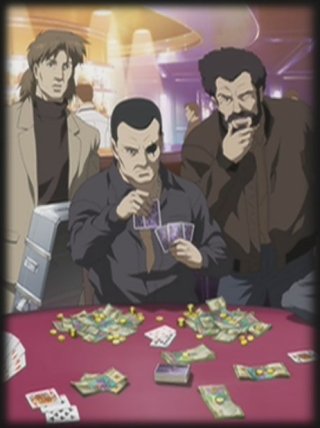
Togusa and Ishkawa watch Saito play cards
In a previous post, I mentioned that Major Kusanagi tends to wear… suggestive… outfits. I found it a little odd. Steven Den Beste noted that it could be a character trait:
As to why Kusanagi wears lingerie a lot of the time, that might well be explainable in character terms. Remember that she’s a full-replacement cyborg. The only “original equipment” left is her brain. All the rest is mechanism.
At least based on the movie, it’s apparent that some full-replacement cyborgs have doubts about just how human they really are. The body is arbitrary; it can easily be changed. Kusanagi’s brain could have been put into a male-form body, or into something that didn’t look human at all.
Having a sexy form (e.g. with entirely cosmetic breasts) and emphasizing that sexiness with skimpy clothing might be part of her psychological need to reassure herself that she’s still a woman, and not just a machine with a human brain inside it.
I don’t know if I fully buy that, but it’s certainly an interesting conjecture. The Major does get “dressed up” for formal occasions, and she actually manages to wear pants for a good portion of the episodes. Still, I found it a little odd. At one point, while wearing an especially skimpy outfit, Chief Aramaki actually calls it out as being strange, which I thought was kinda funny. In any case, the psychological implications of being a full replacement cyborg certainly play a role in the series. As full replacement cyborgs, they often cling to objects that have sentimental meaning to them – the Major has a watch. This is basically a way of reminding herself that she’s still human (or that she was human). As these things go, the Major is actually not that sentimental, but Batou certainly is. He lifts weights (but since he’s a cyborg, he has no muscle tissue, so the act has no real meaning other than to connect with his humanity), he has a favorite Tachikoma, and in the movies he has a basset hound. Anyway, here are some pics of the Major:
And just for good measure, here are some of the vehicle designs in the series. The creators seem to have a thing for propellers.
And that about wraps things up. Up next is Banner of the Stars. I actually have the DVDs in hand this time, so it should be a relatively quick watch…
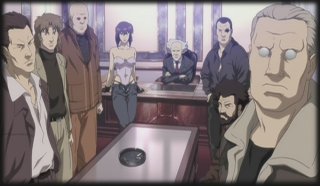
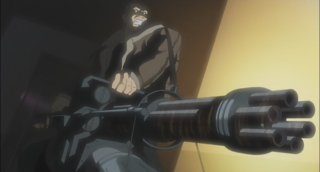
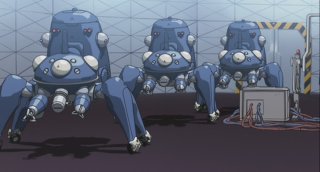
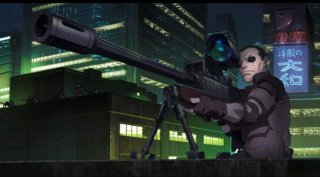

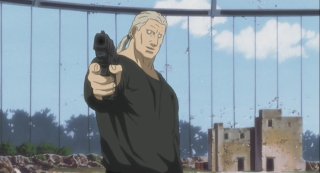

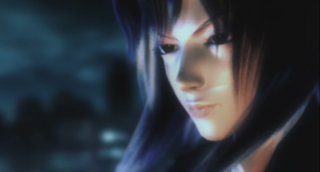
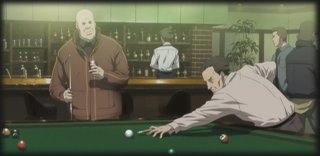
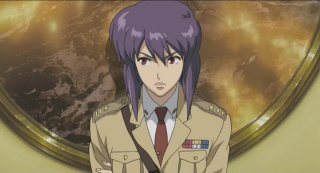


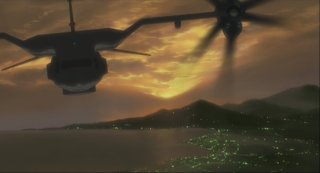
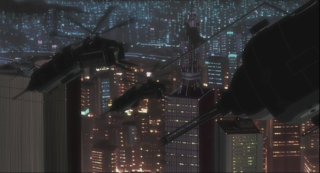
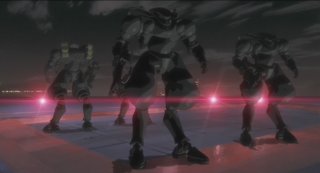
I think my antipathy to tachicomas is not typical. Most people love them.
I wouldn’t say that I loved them (as I mentioned, there are some things I found odd about them), but I did like the implications of their technology… and while I found the “kawai combat vehicle” to be odd, it was also entertaining. I can see why most people would love them.
ps – thanks for the link:)
Good luck with the Banner.
No sooner I mentioned banner when I came acros this:
http://i14.photobucket.com/albums/a343/ptj_tsubasa/lafiel.jpg
good news, i actually just got MOD to work in IE (dunno why it wasnt earlier). gits:sac is at the top of my list, thanks to your post 🙂
do i need to have watched previous installments, though?
pete – for some reason that pic reminds me of Akane. maybe i just have ranma on the brain.l
Pete, I’m looking forward to it.
Aziz, No, the series is independent of the movies. It might be worth watching the first movie (which is also on Netflix’s streaming thingy), but I don’t think it’s necessary.
“The original creator might have never existed at all… It is possible to create copies without an original.”
This may sound confusing to most people because there must always be a creator for something and there is always an original for every copy. But I think what this means is that the supposed original creator did not supposed his creation or action to be called as such, and it may even be something that was made out of accident or something that the he did not intend to be interpreted as what it is later considered as. I think that’s what the standalone complex is about. There are copies, but an original might actually not existed at all. For example, if it’s a popular prank, the original creator of that “prank” did not even intend it to be a prank at all, but eventually people started imitating it and it became popular as a prank.